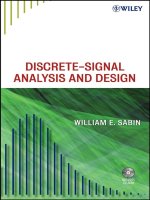DISCRETE-SIGNAL ANALYSIS AND DESIGN- P27 pps
Bạn đang xem bản rút gọn của tài liệu. Xem và tải ngay bản đầy đủ của tài liệu tại đây (155.14 KB, 5 trang )
116 DISCRETE-SIGNAL ANALYSIS AND DESIGN
VL(k), PL(k)= VL(k)
2
[G
B
(k) +G(k)] watts. If G(k) + G
B
(k) = 0, the
imaginary power (vars) PL(k) =±jB(k)×VL(k)
2
.
The real part of the power PL(k) is converted to radio or sound waves or
heat dissipation of some kind, and the imaginary part is cycled back and
forth between energy storage elements (lumped components) or stand-
ing waves (transmission lines) of some kind. This energy cycling al-
ways involves slightly lossy storage elements that dissipate a little of the
real power.
Example 7-1: The Use of Eq. (7-2)
Figure 7-2 is an example of the use of Eq. (7-2). The x (n) input signal
voltage waveform in part (a) is a complex time sequence of cosine and
sine waves. This Þgure uses steps of 0.1 in the (n) values for better visual
resolution, and this is the only place where x(n) is plotted. The two plots
in part (a) are I (n) (real) and Q(n) (imaginary) sequences that we have
looked at previously. Parts (b) and (c) are the DFT of part (a) that show
the two-sided phasor frequency X (k) voltage values. The DFT uses (k)
steps of 1.0 to avoid spectral leakage between (k) integers (Chapter 3).
If a dc voltage is present, it shows up at k =0 (see Fig. 1-2). In this
example there is no dc, but it will be considered later. The integer values
are sufÞcient for a correct evaluation if there are enough of them to satisfy
the requirements for adequate sampling.
In part (d) the two-sided phasors are organized into two groups. One
group collects phasor pairs that have even symmetry about N /2 and are
added coherently (Chapter 1). These are the cosine (or j cosine) terms.
The other pairs that have odd symmetry about N /2 are the sine (or the
j sine) terms and are subtracted coherently. This procedure accounts for
all phasor pairs in any signal, regardless of its even and odd components,
and the results agree with Fig. 2-2. Plots (f) and (g) need only the positive
frequencies. Note also that the frequency plots are not functions of time,
like x(n), so each observation at frequency (k) is a steady-state measure-
ment and we can take as much time at each (k ) as we like, after the x(n)
time sequence is obtained.
Part (e) calculates the load admittance Y(k) = G(k) ±jB(k) at each
(k) for the frequency dependence that we have speciÞed. The plot in part
(f) shows the complex value of Y (k) at each (k).
THE POWER SPECTRUM 117
0 5 10 15 20 25 3
0
−10
0
10
Re(x(n))
Im(x(n))
n
(a)
(b)
N := 32 R := 1n := 0, 0.1 N − 1 k := 0, 1 N − 1
x(n) :=
n
N
3⋅cos 2π⋅ ⋅1
n
N
+ 4⋅j⋅sin 2⋅π⋅ ⋅3
n
N
+ 5⋅j⋅cos 2⋅π⋅ ⋅5
n
N
− 6⋅j⋅sin 2⋅π⋅ ⋅7
∑
N−1
n = 0
X(k) :=
1
N
x(n)⋅exp
n
N
−j⋅2⋅π⋅ ⋅k
0 5 10 15 20 25 3
0
−5
0
5
k
Re(X(k))
(c)
(d)
(e)
(f )
XE(k) := X(k) + X(N − k) XO(k) := X(k) − X(N − k)
(Y(k)) := 1 + j·
k
4.5
01234
k
5678
−1
−0.4
0.2
0.8
1.4
2
Re(Y(k))
Im(Y(k))
(
g
)
01234
k
5678
−5
0
5
10
15
Re(PL(k))
Im(PL(k))
PL(k) :=
(XE(k))
2
+ (XO(k))
2
(1 + R·Y(k))
2
·Y(k)
.
Figure 7-2 Power spectrum of a complex signal: (a) complex two-sided
time domain, real and imaginary; (b) complex two-sided phasor voltage
spectrum; (c) complex two-sided phasor voltage spectrum; (d) even and
odd parts of phasor spectrum; (e) load admittance deÞnition; (f) load
admittance plot; (g) load power spectrum after Þltering.
118 DISCRETE-SIGNAL ANALYSIS AND DESIGN
In part (g), Eq. (7-2), the positive-frequency complex power PL(k )
as inßuenced by the complex load admittance Y (k ), is calculated and
plotted. This power value is due to two separate and independent power
contributions. The Þrst is due only to the XE (k) terms (the even terms) that
are symmetrical about N /2. The second is due only to the XO(k) terms
(the odd terms) that are odd-symmetrical about N /2. In other words, the
power spectrum is a linear collection of sinusoidal power signals, which
is what the Fourier series is all about. If a certain PL(k ) has a phase angle
associated with it, Mathcad separates PL(k ) into an even (real) part and
an odd (imaginary) part. Also, the power spectrum can have an imaginary
part that is negative, which is determined in this example by the deÞnition
of Y (k), and the real part is positive in passive networks but can have a
negative component in amplifying feedback networks [Gonzalez, 1997].
If there is a dc component in the input signal x (n)inpart(a),adc
voltage will be seen in part (c) at zero frequency. Part (g) includes this
dc voltage in its calculation of the dc power component in PL(k ). Note
that part (f) shows an admittance value at k =0 that can be forced to zero
using a dc block (coupling capacitor or shunt inductor).
As an alternative to the use of exact-integer values of (k ) and (n), the
windowing and smoothing procedures of Chapter 4 can greatly reduce
the spectral leakage sidelobes (Chapter 3), and that is a useful approach
in practical situations where almost-exact-integer values of (n) and (k )
using the rectangular window are not feasible. The methods in Chapter
4 can also reduce aliasing (Chapter 3). These windowing and smoothing
functions can easily be appended to x (n) in Fig. 7-2a.
At this point we would like to look more closely at random noise.
RANDOM GAUSSIAN NOISE
The product of temperature T in Kelvins and k
B
, Boltzmann’s constant
(1.38 ×10
−23
joules per kelvin), equals energy in joules, and in conduct-
ing or radiating systems this amount of energy ßow per second at constant
(or varying) temperature is k
B
T watts (joules per kelvin per second). T is
quite often 290K or 17
◦
C (63
◦
F) and k
B
T =4 ×10
−21
watts, the electrical
thermal noise power that is available from any purely resistive electri-
cal thermal noise source in a 1.0-Hz bandwidth at a chilly “laboratory”
THE POWER SPECTRUM 119
temperature, and
P(avail) = 10 log
4.0 × 10
−21
0.001
(1.0)
=−174 dBm (7-3a)
where the 0.001 converts watts to milliwatts. If the noise bandwidth is B
and the temperature is T, then
P (avail) =
−174 + 10 log(B/1.0) + 10 log(T /290)
dBm (7-3b)
Some resistance values are not sources of thermal noise and do not dis-
sipate power. These are called dynamic resistances. One example is the
lossless transmission line whose characteristic resistance, R
0
= V
ac
/I
ac
,
such as 50 ohms. Another dynamic resistance is the plate (collector) resis-
tance of a vacuum tube (transistor), dv/di , which is due to a lossless
internal negative feedback effect. Also, a pure reactance is not a source of
thermal noise power because the across-voltage and through-current are
in phase quadrature (average power =0).
This thermal noise has an inherent bandwidth of, not inÞnity, but
up to about 1000 GHz, (1.0 THz) where quantum-mechanical effects
involving Planck’s energy constant (6.63 ×10
−34
joule-seconds) start to
cause a roll-off [Carlson, 1986, pp. 171–172]. For frequencies below this,
Eq. (7-3) is the thermal noise available power spectral density unless addi-
tional Þltering of some type further modiÞes it. We note also that Eq. (7-3)
is the one-sided (f ≥0) spectrum, 3 dB greater than the two-sided value.
The two-sided value is sometimes preferred in math analyses. Thermal
noise has the Gaussian (normal) probability density (PDF) and cumulative
distribution (CDF) previously discussed in Chapter 6. The thermal noise
signal is very important in low-level system simulations and analyses.
The term white noise refers to a constant wideband (<1000 GHz,
1 THz) value of power spectrum (see the next topic) and to essentially zero
autocorrelation for τ = 0 [Eq. (6-12)]. As the system bandwidth is greatly
reduced, these assumptions begin to deteriorate. At narrow bandwidths
an approach called narrowband noise analysis is needed, and real-world
envelope detection of noise combined with a weak signal imposes addi-
tional nonlinear complications, including a “threshold” effect [Schwartz,
1980, Chap. 5; Sabin, 1988]. A common experience is that as the signal
120 DISCRETE-SIGNAL ANALYSIS AND DESIGN
increases slowly from zero, an increase in noise level is noticed. At higher
signal levels the noise level is reduced as the detector becomes more
“linearized”.
MEASURING POWER SPECTRUM
The spectrum analyzer (or scanning spectrum analyzer) is an excellent
example of a power spectrum instrument. The horizontal scale (usually,
a linear scale) indicates frequency increments, and the vertical scale is
calibrated in dB with respect to some selected reference level in dBm
at the top of the display screen. Frequency resolution bandwidth values
from 1 Hz (very expensive) to 100 MHz are common. The data in modern
instruments is stored digitally in one or more memory registers for each
resolution bandwidth value, and this data can be processed in many differ-
ent ways. We can think of the spectrum analyzer as a discrete-frequency
sampler at frequencies (k). The amplitude X (k ) is usually also stored in
digital form.
One especially interesting usage is the “peak hold” option, where the
frequency range is scanned slowly several dozen times, and any increase
in the peak value at any frequency is preserved and updated on each
new scan. A steady-state pattern slowly emerges on the screen that is
an accurate display of the power spectrum. The analysis of random or
pseudorandom RF signal power spectra such as speech or data is greatly
facilitated. The input signal must be strong enough to override external
and internal noise contamination. Moderately priced instruments often
have this very valuable feature, and this is an excellent way to evaluate
signals that have long-term randomness.
Figure 7-3 is derived from a photograph of a spectrum analyzer display
of a long-term peak hold of a radio frequency 600 watt PEP single-side-
band adult male voice signal that shows a speech frequency passband
from about 300 Hz to about 3 kHz above the suppressed carrier frequency
f
0
. The resolution bandwidth is 300 Hz. The lower speech frequencies are
attenuated somewhat in order to emphasize the higher speech frequencies
that improve readability under weak signal conditions. The low levels of
adjacent channel spillover caused by the inevitable nonlinearities in the
system (the transmitter) are also shown. Note the > 40-dB attenuation at









